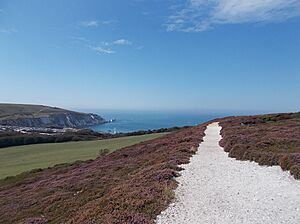Headon Warren and West High Down SSSI facts for kids
| Site of Special Scientific Interest | |

View from Headon Warren towards West High Down and the Needles
|
|
| Area of Search | Isle of Wight |
|---|---|
| Grid reference | SZ316852 |
| Interest | Biological and Geological |
| Area | 276.3 hectare |
| Notification | 1951 |
Headon Warren and West High Down is a special natural area covering about 276.3 hectares (that's over 680 acres!). It's located at the very western tip of the Isle of Wight in England. This amazing place includes Headon Warren, which is a hill covered in heather, and the chalk hills of West High Down and Tennyson Down. It also stretches to famous landmarks like the Needles, The Needles Batteries, and Alum Bay.
This site was officially recognized in 1951 because of its important plants, animals, and geological features (like rocks and fossils). Today, it's mostly looked after by the National Trust, an organization that protects special places.
Contents
Discover Headon Warren and West High Down
This whole area is known as a Site of Special Scientific Interest (SSSI). This means it's a place that is protected because it has rare wildlife, plants, or important geological features. Headon Warren is a type of lowland heath, which is a wild, open area with low-growing plants like heather. West High Down and Tennyson Down are chalk hills, which have a different kind of grassy habitat.
What Makes This Place Special?
One of the most interesting things about Headon Warren and West High Down is how close these two very different natural areas are. You have the acid heathland right next to chalk grasslands. This mix of environments in a coastal setting makes it a unique spot for scientists to study. It's like having two different worlds of plants and animals living side-by-side!
Amazing Plants You Can Find Here
On Headon Warren, you'll see lots of beautiful plants like heather and bell heather, which give the landscape a purple glow. You'll also find gorse and dwarf gorse, which have bright yellow flowers. These plants create a perfect home for many heathland creatures.
The chalk hills of West High Down and Tennyson Down are home to a different set of plants. Here, you can find nine different types of orchids, which are beautiful and often rare flowers. There are also large groups of very rare plants like early gentian and tufted centaury. Even on the steep cliffs, special plants like hoary stock and rock samphire manage to grow.
Wildlife and Birds of the Cliffs
This area is a haven for many animals. The Dartford warbler, a small bird, makes its home and raises its young on Headon Warren. The cliffs are especially busy with birds. You can spot many types of seabirds nesting here, including herring gulls, fulmars, kittiwakes, cormorants, and shags.
If you're lucky, you might also see smaller numbers of razorbills, puffins, and guillemots. These birds often gather in large colonies on the cliff faces. High above, the powerful peregrine falcon, one of the fastest birds in the world, also breeds in this protected area.
Uncovering Ancient Rocks and Fossils
The coastline between Alum Bay and Totland Bay is a fantastic place for geology enthusiasts. Here, you can see a complete sequence of sedimentary rocks. These are rocks formed over millions of years from layers of sand, mud, and other materials. You can trace the layers from the very old Chalk Group up to the Bembridge Limestone.
Scientists have found many amazing fossils in these rocks. These include fossils of ancient mammals and reptiles from the Tertiary period, which was a very long time ago in Earth's history. There are also many important plant fossils, giving us clues about what the environment was like millions of years ago.

